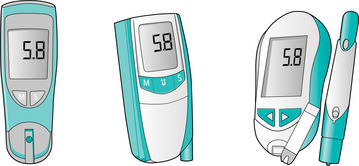Learning outcomes
By the end of this section, you should know how to:
▪ collect and prepare the equipment
▪ prepare the patient for this nursing practice
▪ carry out blood glucose measurement.
Background knowledge required
Anatomy and physiology of the endocrine system, with special reference to the regulation of blood glucose
Clinical knowledge of insulin-dependent and non-insulin-dependent diabetes
Target range of individual patient blood glucose level
Knowledge of the normal range of blood glucose concentration
Manufacturer’s information on the selected test strip
Knowledge of different blood glucose meters and devices used to obtain the blood sample and to measure blood glucose level
Revision of local policy on blood glucose monitoring
Principles of infection control with respect to blood-borne infection.
Indications and rationale for blood glucose estimation
Blood glucose estimation is the measurement of the level of blood glucose using a chemical test strip. This investigation may be carried out to:
▪ assist in the preliminary diagnosis of diabetes mellitus caused by pancreatic disease or other hormonal disorders through the measurement of the level of glucose in the blood
▪ monitor the blood glucose level in patients with established diabetes in order to facilitate an acceptable blood glucose level and to detect abnormal levels (Watkins 2003)
▪ monitor patients receiving parenteral nutrition (see p. 237) to ensure that the blood glucose level is kept within an acceptable range.
Outline of procedure
The nurse must be aware of the theory underpinning glucose monitoring practice and have a knowledge of the normal range of blood glucose level in order that any abnormal readings may be immediately recognised and treatment initiated according to local policy. Blood glucose levels are measured in mmol L1. Diabetes UK (http://www.diabetes.org.uk/home.htm) currently recommends that people with diabetes should aim to keep their blood levels between 4–6 mmol L1 before meals (pre-prandial) and at no higher than 10 mmol L1 two hours after meals (post-prandial). The acceptable range for each individual patient (particularly with long-standing diabetes) may vary slightly but should be identified by the medical practitioner and recorded in all patient documentation. Health promotion may be carried out in relation to an underlying disease, for example in a diabetic patient attending for blood glucose monitoring. Aldridge (2005) advises that any education programme should take account of achievable patient goals, and individual preference for finger-pricking devices and glucose meters.
 Equipment
Equipment1. Finger-pricking device
2. Cotton-wool balls
3. Blood glucose testing strip
4. Disposable gloves
5. Tray for equipment
6. Sharps box
7. Receptacle for soiled material
8. Patient documentation and personal diabetic diary (if appropriate)
9. Blood glucose meter.
 Guidelines and nursing practice
Guidelines and nursing practiceThere are several different blood glucose pricking devices and meters available in the UK (Fig. 3.1), so the manufacturer’s instructions for use must always be followed. Diabetes UK (http://www.diabetes.org.uk/home.htm) provides up-to-date information on a wide range of devices and meters.
 |
| FIGURE 3.1Blood glucose monitoring devices |
▪ familiarise yourself with the instructions for the device you are using to ensure a correct safe practice
▪ check the expiry date of the test strip to ensure that the strips are within the ‘use by’ date
▪ confirm that the device is calibratedto the test strip to reduce the risk of an error with the result
▪ discuss the practice with the patient to inform the patient about the practice and to discuss any concerns or queries
▪ obtain consent from the patient to undertake the practice to ensure that the patient is aware of his or her rights
Stay updated, free articles. Join our Telegram channel

Full access? Get Clinical Tree


Get Clinical Tree app for offline access
